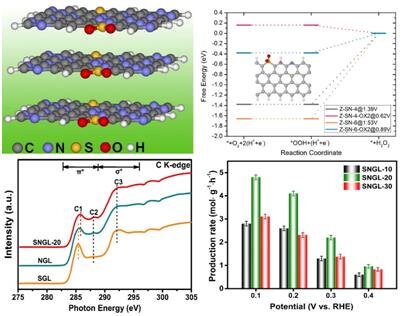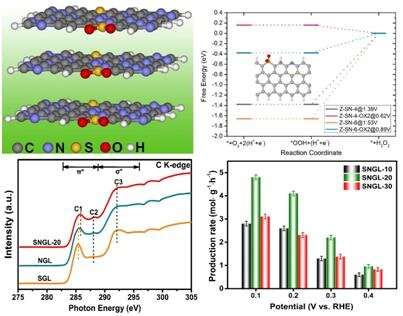

As one of the 100 most important chemicals in the world, hydrogen peroxide (H2O2) is mainly produced by the energy- and waste-intensive anthraquinone oxidation (AO) method. Replacing the AO method with a more environmentally-benign electrochemical two-electron oxygen reduction reaction (2e– ORR) depends on cheap and efficient catalysts.
However, metal-free, carbon-based catalyst as a promising candidate behaves encouragingly only under neutral or alkaline conditions, where H2O2 is unstable for collection or unfavorable for linking applications, i.e., the e-Fenton reaction. Moreover, it remains challenging to identify the real active catalytic sites and the underlying 2e– ORR mechanism.
In a study published in Chem Catalysis, a research group led by Prof. Guan Lunhui from the Fujian Institute of Research on the Structure of Matter of the Chinese Academy of Sciences developed a metal-free, highly efficient acidic 2e– ORR catalyst with recorded hydrogen peroxide production rate based on pyrimidine-assisted active site modulation and S, N-codoped few-layered graphene for valence electronic optimization.
The catalyst exhibited exceptional activity and selectivity for 2e– ORR in acid. The H2O2 selectivity reaches 90%~100% over a potential range of 0.20~0.55 V and the maximum H2O2 production rate (4.8 mol·g-1·h-1) exceeds all the reported H2O2 production performance for carbon material-based catalysts.
Experiments and density-functional-theory simulations (contributed by Prof. Chai Guoliang) revealed that the synergy effect of the combined oxidized sulfur and pyridinic-N functional motif can lower the Fermi level of valence electronic states of active edge carbon sites, and thus leads to suitable binding strength of *OOH intermediate for high selectivity and performance 2e– ORR for H2O2 formation.
In particular, the researchers observed an obvious peak-shift to high energy of C 1s excitation in near edge X-ray absorption fine structure with S incorporation, as solid evidence for the valence electronic optimization of carbon catalyst surface.
In addition, coupled with Fenton reaction for an electron-Fenton process, it can degrade a model organic pollutant (methylene blue [MB], 50 ppm) to colorless in a short time of 15 min.
This study not only creates an efficient carbon-based catalyst for H2O2 production in acid, but also provides a useful electronic property optimization route for future tuning of carbon-based materials catalysts.
Uniform single atomic sites anchored in graphdiyne for benzene hydroxylation to phenol
Jiaoxing Xu et al, Pyrimidine-assisted synthesis of S, N-codoped few-layered graphene for highly efficient hydrogen peroxide production in acid, Chem Catalysis (2022). DOI: 10.1016/j.checat.2022.04.011
Chinese Academy of Sciences
Citation:
Researchers realize efficient hydrogen-peroxide production in acid (2022, May 30)
retrieved 30 May 2022
from https://phys.org/news/2022-05-efficient-hydrogen-peroxide-production-acid.html
This document is subject to copyright. Apart from any fair dealing for the purpose of private study or research, no
part may be reproduced without the written permission. The content is provided for information purposes only.